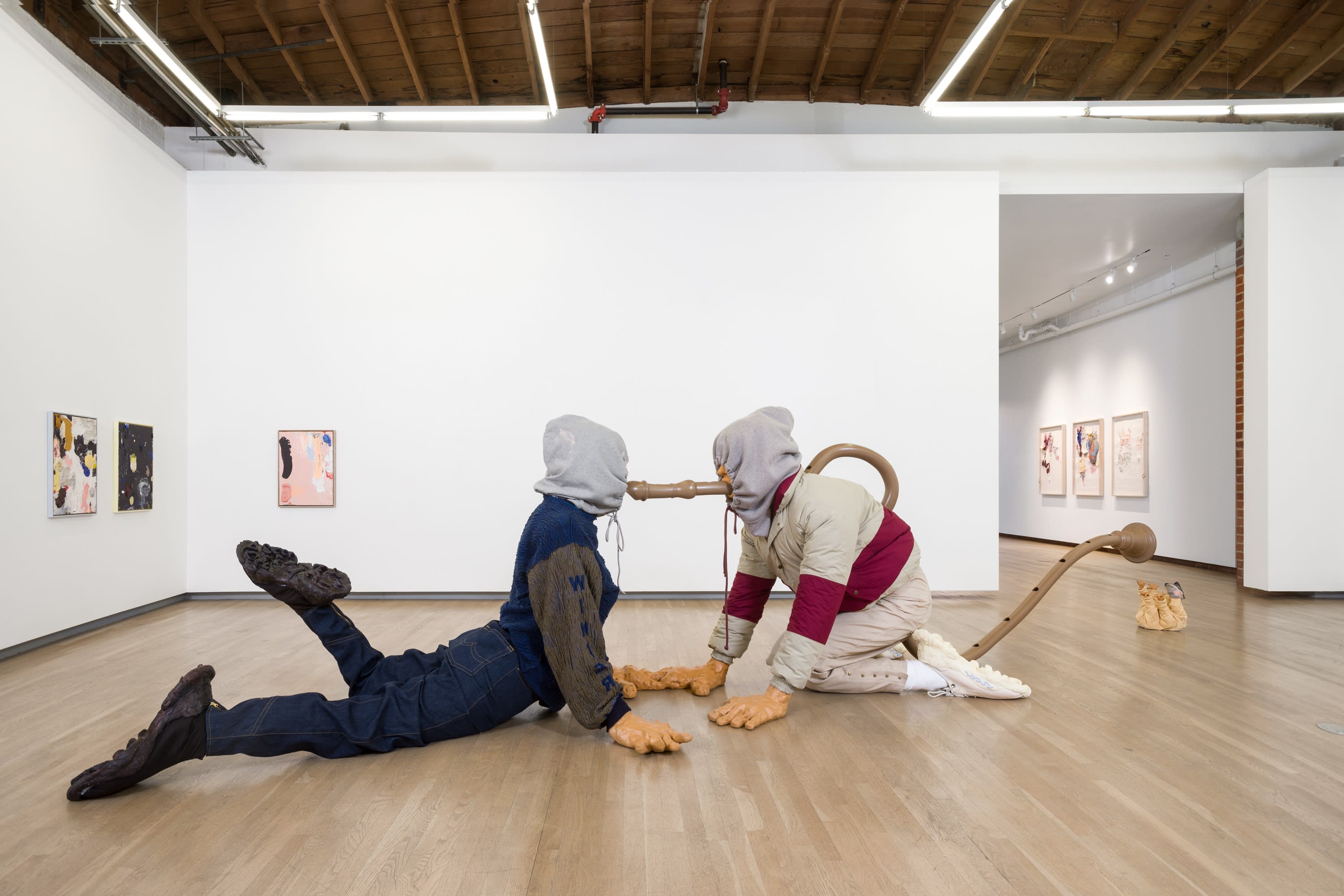
A perennially maligned staple of Nordic folklore, the troll has been repurposed for the current moment. Notoriously base and mean-spirited, trolls now sneak into your Twitter feed like they once snuffled out from under bridges to snare billy goats, their intent to disrupt and derail. Trolls feature prominently in Tori Wrånes’s work, but the Norwegian sculptor and performance artist challenges the stereotypes that define them, repositioning these spectresof Norse mythology and the dark corners of the internet as iconoclasts; their dirges mourning the environmental collapse that remains largely unaddressed by the planet feeling its effects.At Shulamit Nazarian, she performed a new iteration — each performance is improvised — of her 2018 work ECHO FACE in costume, with buggy eyes and wing-nut ears plastered below her own and wearing a comically tall cowboy hat.
Wrånes is celebrated for her work as a vocalist, performing trancelike melodies in a tongue she describes as "troll language." While live (and particularly extemporised) performance always carries an element of risk, much of Wrånes’s performance work places the artist in physical danger: she has performed in costume as a ‘troll’ of her own fashioning while a massive rock swung centimetres from her head (Stone and Singer, 2014), into the muzzle of a flare gun (Solo, 2011) and while hanging from a construction crane 12 metres in the air (Crane Ballet, 2016). The artist and her performers variously don prosthetic ears, noses, tail, skin treatments, mullet wigs and other cosmetic enhancements, and appear in contemporary clothes or full furry bodysuits, but they are always conspicuously "other."
However in Mussel Tears the artist’s sculptural practice is given primary importance, her sculptures serving as physical embodiments of the iconography that shapes her visions. Here, we absorb at close range the irregular beings previously seen lurching, creeping or gliding through her performances, as well as the themes that inform them.

MUSSEL TEARS, 2022 (INSTALLATION VIEW). PHOTO: ED MUMFORD. COURTESY THE ARTIST AND SHULAMIT NAZARIAN, LOS ANGELES
Just as the doubled facial features of Echo Face suggest hybridity and fusion, Wrånes plays with physical boundaries in these static works, fusing the bodily appendages of several constructions to suggest near-continuous loops. In the front gallery the viewer encounters Fifth Leg (2022), a sculpture in acrylic-painted resin, urethane foam and steel, of a cat and a dog whose gazes meet above their shared tail. Mothers and Child (2022), a massive sculpture composed of Lucite, urethane foam, PVC, birch, concrete, paint and textiles, dominates the main gallery. In keeping with the artist’s interest in extravagant gestures, the 6.5m-long work features two giant sprawled and crouching figures wearing jeans, hoodies and other articles of clothing that could be mistaken for commercially fabricated except for their twice-lifesize proportions. The duo are joined both by their melded fingers and a fleshy-hued recorder that extends from the mouth of one to that of the other before exiting between her legs as a trumpet bell, the effect suggesting both an umbilical cord and an extraordinarily long phallus. Nearby a jumpsuited, sneakered baby extends its four arms towards the bell as if clambering for it; however, the pair are absorbed in their song. As if emitting from the second figure’s asshole, a piped recording of Wrånes playing an alto recorder permeates the room. The absence of the child’s head echoes the hood-obscured faces of its mothers. While tender, the work implies fomenting disconnect and discord.
This striking sculpture is joined by wall works, all titled Mussel Tears (2022), featuring mussel shells encased in teardrop-shaped concrete that serve as memorials to the molluscs that once thrived in Kristiansand, Norway, the artist’s birthplace. In the 40-some years since her birth, the area’s coastline has experienced environmental change so profound that these natural filters of the sea have all but vanished. The theme of tenuous interconnectivity is everywhere, as is the implication of the dire consequences of any one corroded link. Like the baby left on the floor, disregard for that which sustains and regener- ates life permeates the exhibition.
I have a recurring dream of stumbling and falling, unable to walk, and thus to escape my assured demise. By contrast, Wrånes’s trolls — which she uses as a shorthand for any beings that go against the grain — are fully ambulatory and independent, yet irrevocably linked to the ecologies of the sites in which they appear. Unencumbered by convention, these mythical disruptors are perhaps better suited than us to convey the consequences of indifference.


